LILA: Thank you Lynn, for participating in this conversation on Evolution with us today. Your work has been fascinating to explore given its deep dive into the history of humankind and our planet. But before you found yourself at excavation sites, amongst some of the oldest fossils known to scientists today, you worked mostly with paper, pulp and landscapes. Please tell us a little about the evolution of your own art practice over the years and across formats.
Lynn Sures: Thanks, LILA and Inter-Actions, for the opportunity to converse with you. To share some of the backstory of my practice, from early on I noticed the landscape. My studies centred on painting, drawing, and printmaking. Later, I met other artists who introduced me to new techniques in the family of what I knew—paper-making and book arts, for example. Meanwhile I had the chance to see the phenomenal American west and southwest, and was learning about geology from a geologist friend, and from a textbook. I wanted to “see” the impossibly lengthy geological processes, which meant I had to make images of them, so I did, using wet, coloured paper pulp as my paint, a process called pulp painting.
Reflecting on how mountain ranges grow through plate tectonics, whereas erosion wears them down, I was fixed on the thought that we could “see,” in this way, surfaces of landscape that had never before been seen. That led to thoughts of fossils imbedded in the landscape, also brought to light by erosion. I started reading at the library about ancient human fossils, and making small studies, surreptitiously, at museum displays. There I found scientists who invited me to visit their offices and draw further.
Opportunities to visit different places struck me with the diversity of the world: Europe, Australia, Sri Lanka, Japan, and Mexico each held for me new stories and new traditions. Two sculptural techniques I acquired—through classes and residencies; sometimes by chance—were understood through my lens as a painter. I learned hand-building ceramic sculpture, a very tactile and painterly technique, by sculpting large-scale clay pieces out of the drawings I had drawn inside caves in Italy. I also learned how to forge steel, which seems so much like painting with a hammer and hot iron. The forged steel pieces are primarily book covers for my sculptural artist books.
The Smithsonian Artist Research Fellowship took me to Kenya to draw excavation sites and museum fossils. I made paper and brought it to Kenya, drawing constantly in colour to obtain a full record of what I saw. I journaled extensively to record the education I was receiving, the conversations, and my thoughts about every experience and every site. These sources continue to feed my practice; and returning from Kenya I’ve had a Research Associate fellowship to continue learning about fossils, making my drawings at the Smithsonian in the Human Origins Program.
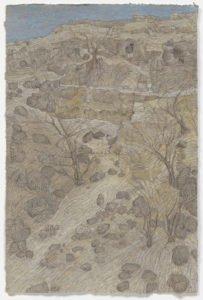
The different media and techniques—painting, drawing, paper-making, printmaking, sculpture, book arts—and the expanding foci of subjects all remain in use for me, because I love working in all of them and don’t want to lose any of them. The constant in my practice is that at any given time, a specific series of work on a specific concept dominates; I use the technique or medium that permits making that series of work honestly, rather than defining myself as an artist who works in a certain medium. Instinct and sometimes opportunity guide what to make and how.
LILA: You mention that reliving a place or an experience—from site narratives to simply the awareness of a moment—is often the reason for you to work. In this process of accessing from memory, how is the external embodied and the internal externalised? What role does your art play in this back-and-forth engagement with memory — or vice versa?
LS: Memory is powerful. When memory is sparked by a smell, a word, a person, a place, the remembered experience is vividly brought back to life. At the excavation sites where Homo erectus had worked at Olorgesailie, Kenya, my conscious brain was fully engaged in the “what” and “where.” Sitting at the Handaxe Quarry, I saw the flaking scars on the boulders. I knew the hominins had practiced their industry just where I was then drawing. In my mind I “heard” the noises of tool-making. The Quarry site emerged slowly from the coloured pencil traces on my handmade paper. A passing Maasai shepherd walking with his flock shared a greeting with me as I drew alone at the desert site. I half-completed many drawings in Kenya and wanted more time with them. In my studio in Maryland, USA, as soon as I held my coloured pencil to a half-finished drawing, I was fully back at Olorgesailie; so strong was the pull of memory evoked by physically and visually engaging with the drawing itself.
A fossil is an assembly of replacement molecules that preserve the form and shape, size and scale, proportions, the relatively fine details, of an entity or impression—while the original molecular composition could not have spanned the distance in time and space that the replacement molecules have been able to do. Fossilisation is a record a living thing leaves; thus, we find a palpable link between ourselves in our time and space, and other travellers in another time and space. Like a photograph, it is a kind of printed likeness of a physical thing in a specific moment in time and space.
In this way I can feel that we are a part of a continuum, not unique, not alone. The fossils have stories. Circeo 1 was found south of Rome, Italy in an ancient hyena’s den, where he met his death 60,000 years ago. The Qafzeh nine fossil was found nearly complete, a full skeleton, and buried by her feet was a child’s skeleton, 95,000 years ago. These stories convey a kind of memory to me, feeding the artworks that ensue.
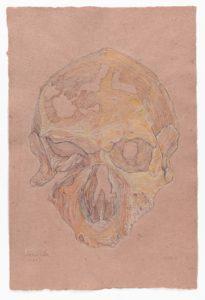
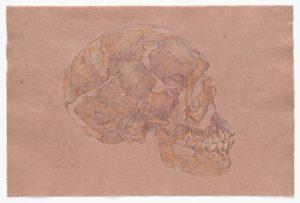
LILA: Do you think there is a uniqueness in not feeling unique in the world we live in today—being connected to history in the way that you are, which at once makes your exposure unique, yet positions you on a continuum where you don’t see yourself as that? How does this make you reflect on human evolution—from the stories you discover of the ages gone by, to the stories you experience here and now?
LS: There are so many people in the world that it’s hard to imagine anyone being unique now. In Australia, I first saw the Southern Hemisphere’s night sky—for me a new reality . . . which many in the world have always known. Seeing Kenya’s Mt. Olorgesailie in the moonlight, in a strong wind, my mind drifted to ancient beings who knew that mountain and felt that moving air on their skin; a knowledge shared over time. If I were completely unknown, my work unseen, I am sure I would still spend my time working in the same way. For my new series of sculptural books, “Time Is Not Linear,” I considered what I have read on the laws of physics. The incomprehensible enormity of the universe, and duration of time, places everyone from every era in “nano” stature, individually. Yet, this translates to a sense of unity and belonging, because all of us through the ages are in that same state. As a student, at a museum, I looked at a mummy case and was aware that my hand physically understood the hand of the ancient painter brushing the paint. It was a lightning strike, that commonality with someone long gone. The act of drawing fossil footprints now evokes in my mind the early hominins who left their prints in volcanic ash. I sense their feet engaged in making marks more than a million years ago—and those hominins are unique, in that their footprints endure. It is unique that I have the support of the Smithsonian, that opportunity to learn and describe and produce, to share what I come to understand. Though so many artists, globally, have support in so many ways for what they seek.
Contemporary socio-political stories in my own country and globally are shocking, ubiquitous, and disturbing. I am painfully aware of them, but I distance them from my studio practice. The stories that do actually enter my work on a tangential level might be those works of contemporary fiction read by the author or by a noted actor, a counterpoint to my creative visual work, which I listen to in the studio, and which unburden me, as music does too, taking my conscious mind away from concerns of the day.
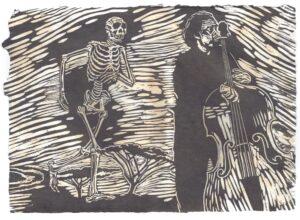
Stories of ancient eras come my way from conversations with the scientists I know, and from the scientific articles and books I read, which offer reams of information about our origins. Scientists not only make discoveries, but analyse and discuss their findings—contextualising, elucidating, presenting vivid scenarios. Investigations made into the evolution of our human intellectual and cultural characteristics pique my attention. The diversity of physical characteristics that currently fuel much fear and hatred are all very new in an evolutionary sense—our skin and hair differentiations having only appeared about 30,000 years ago, after such a very long evolutionary process, in response to the different parts of the world we spread to, adapting to the conditions we found there. Certain marks on a fossil bone indicate that a Neanderthal individual suffered from a certain disease or disability but lived to an advanced age, indicating the existence of community care. There was interbreeding between Neanderthals and archaic Homo sapiens, resulting in the presence of 1%-4% Neanderthal DNA in all contemporary non-African human populations. The first artists may have been Neanderthals, using the mineral ochre as pigment. The stories of scientists are extensive, engaging, thrilling to an artist who wants to try to understand.
LILA: There is a deep and palpable sense of movement in all you do and write. From what you have just described, my mind goes to your work ‘Variations’, featured in this edition, where one almost feels like a gush of music is carrying them through the book. Similarly, all your drawings of fossils, though documenting something that has been preserved for millennia, seems to evoke a lot of movement within the lines. Is this a conscious choice? Are there any artistic influences that bring this out in your work?
LS: To create what would become “Variations…,” I played Charles Mingus’ piece “Pithecanthropus erectus” on a loop during the time I was developing the book—while designing and painting the colour and shape systems for the pages, while situating the drawings on the painted pages, and while hand writing Rick Potts’ text as fluid, linear components on each page. The sound of Mingus’ music infused each aspect of the creation of the book.
I see and feel things in motion, in several senses. Staring at the fossils for such a long time as it takes me to draw something with focus, I continually scan the surfaces visually, as if touching them with my fingertips. It’s the way I can understand the structure and learn how each disparate part intermingles with every other. While drawing the fossils, too, I’m always aware that I am drawing someone who lived a life, and this impacts the way I interpret them artistically. I often think about how even the most solid matter is only solid with respect to our tactile perception; how its atoms and molecules are in an endless motion—it affects how I construe and construct what I draw.
My work has always carried this trait of movement, but I can’t say if there is a conscious artistic influence that brings it out.
LILA: You’ve mentioned in your ‘Artist Statement’ that in your studio practice, you instinctively recognise yourself on a mission without a clear idea of the formal outcome. We, too, are interested in exploring the significance of the instinct and the uncertainty, for the two are closely associated with ‘Evolution’ as well. Could you elaborate more on that?
LS: I work in a number of different media, separately or combined, to actualise the project in mind. In my studio experience, if I don’t try to tightly control a process, it can go somewhere unknown and valid. It’s possible to step in with direction at any point that’s useful. I’m not saying it’s not hard, because everything’s hard. It’s just that I feel unbelievably at home, in my element, making things.
Artistic ideas are free-flowing when my thoughts in life are bonded with my thoughts in art. We are all connected. We owe our existence through evolution to the first hominins whose fossils have been found extensively in East Africa and in South Africa. As I watch the world’s cultures with concern, as they evolve and devolve in real time, I think about our underlying indelible relationship to each other—and to the earth itself. These are my life thoughts and my art thoughts—the conceptual “why” in my practice.
This has always been a given for me—I do not pre-plan artworks beyond a rudimentary what, why, and how. The idea doesn’t exist in my mind’s eye as a completed work, it’s only a cloudy notion before I begin. There could be a number of solutions to any problem. I have to be at ease with uncertainty; each project is, for a significant period of its process, a challenge without an assured resolution.
I trust my instinct through the vagueness; this is my natural method. I don’t get in my own way by thinking and judging while working, it would set me up for a kind of creative paralysis. Any evolution requires going out on a limb, allowing for accidents and adaptation. Otherwise there’s stasis—no change, no growth, no suspense, no random brilliant developments to seize or harness . . . no evolution.
Impulses go through my head all the time. Every day in the studio, large and fleetingly small intuitive decisions escort a project toward a conclusion. The amorphous, incipient vision coalesces and approaches a tangible presence.
LILA: You note that physical senses, too, help you in working towards the realisation of the initial instinct. Not all can be sensed by “the full range of physical senses,” especially the experiences from memory. In that case, how is the role of physical senses different from that of memory in your practice, if at all? Please comment while keeping the question of the evolutionary significance of our senses in mind.
LS: When working outdoors on site, I feel the wind on my skin, the temperature; I see the colour of a white desert’s sand ridges change as the sun moves across the sky during a full day; I hear the sound of a cowbell punctuating a long day alone, or the sound and chill of water dripping constantly in a cave; I experience hunger and thirst and the smells in the air, and the muscle sensations and awkwardness of sitting for many hours on the ground. All the while I’m fixing my attention on a subject that is irresistible, compelling. The reality that our combination of senses creates for us is rich, layered. The senses are critical in compiling one’s day to day experiences, thus one’s understanding of and ability to navigate one’s world. They have been evolving for our survival requirements as humans since the beginning.
At the Nairobi National Museum and at the Smithsonian in Washington, holding, touching the fossil skulls whose stories I know—such as Turkana Boy, and the animals (a wild boar, a zebra, a hyena) who interacted with our ancient ancestors—evokes the same visceral understanding when drawing on site, and later revived in my own studio.

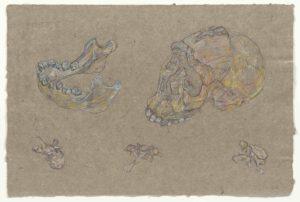
An early human mandible—a lower jaw section—and a molar, were found at Olorgesailie, Kenya, while I was there. I examined the earth matrix with the fossils in place, inevitably noting the light and colour of the sky and the sounds of the people around me; it was a moment of being alive, and an internalised sense that affects my consequent drawings of these fossils.
It is ideal to sit onsite while I draw, to be nourished by place. In long days of drawing sites inhabited in earlier time, I experience sounds and movements shared by the early people. Drawing fossils, I touch, handle, and then can draw Homo erectus, the first tool makers; or the fossils and artefacts of the first artists, the Neanderthals and archaic Homo sapiens. I naturally draw them as once alive, and still communicating—the ancient habitats with their palpable traces, and the ancestors of us humans. In this way, I can speak to human presence, relationship, community, all reaching across time.
LILA: You speak about internalising what you observe or uncover or, let’s say, sense. Could you share more about this experience of sensing and producing that which is, at first, only anticipated at most, specifically with respect to your projects?
LS: I’ve been walking in the woods every day during the year of the pandemic, noticing evidence left in mud or light snow by the deers, racoons, birds, and foxes living there. Their presence in the natural environment is evocative.
Just now I’m in the first stages of studio work, anticipating what might develop in a new installation showing traces left by early hominins in east Africa. I have notions of what might come as I note in a journal: “activate the colour surfaces to create some vibration, to impart action and by implication to render life, activity of molecules, and the conveyance of the trace, the imprint over time.” This parallels evolutionary messaging, which is transferred through our DNA from the most distant past, still contained in our present and future. I’ve been drawing on embossing plates I’ll use in the project, so I know what the general form of the elements will be, but the evolution to take place from this point is enormous. In my mind I imagine surfaces that might come about, and I’m aware of some of the technical steps I’ll undertake. Every project is like this. I don’t want to know the future before it has evolved in its own time.
Traces of early humans in Kenya fill my thoughts with the unknown individuals who left them, where they were going and why, what were their days like, their families like. My mind relaxes into the place where I can readily engage with the challenges of each day in the studio, waiting to see how my work will all eventually take its developmental forms.
LILA: In a long and physical process of creating, “a vivid connection with the material as well as the concept, the reason for being” is central to your practice. Physical senses, as discussed already, are employed in this creation process. How about the physical sense—from the visual to the tactile—that the creations generate for the audience? Is it, according to you, equally significant for the artworks to be read and received well?
LS: Since the beginning, people have desired to see connections and to understand the inexplicable. It was discovered by Einstein that time is not independent from space; and that there is no “absolute time,” and that each observer must have their own measure of time, and that need not agree with the measure of time by another observer in a different space. This refers to extreme conditions of speed and brings to mind the extreme conditions of geological time, engendering fossil artefacts of human lives that existed in an earlier period of our evolution.
On the level of creating the artwork, I don’t work with thoughts of the audience. That would likely get in the way of my being able to work honestly, or from the heart freely. Any concern with the reception of the art would make me self-conscious, and I’m not making things geared to please others, per se. Thus, I don’t have any idea if anyone else will find the artwork rewarding to interact with, until the pieces are finished, and seen by others, and they respond.
If the work that I do brings anyone to contemplate these issues that motivate me—the physical unity of all people alive, the shared ancestry, the shared industry, the futility of judging any people as superior or inferior to any others, the long relationship we have had with the earth—I can only be thankful, gratified, fulfilled.
Regarding that audience’s reading and reception of the artwork, if and when they ultimately interact with the visual, tactile, intellectual aspects of the artwork: if the audience is moved to ask questions or if the objects evoke dialogue or pleasure or argument or appreciation, then that connection with the audience is beautifully satisfying for me. It’s exciting, astonishing to be possible to make that bond with an audience through the communicative properties of art.
Donation to LILA is eligible for tax exemption u/s 80 G (5) (VI) of the Income Tax Act 1961 vide order no. NQ CIT (E) 6139 DEL-LE25902-16032015 dated 16/03/2015
